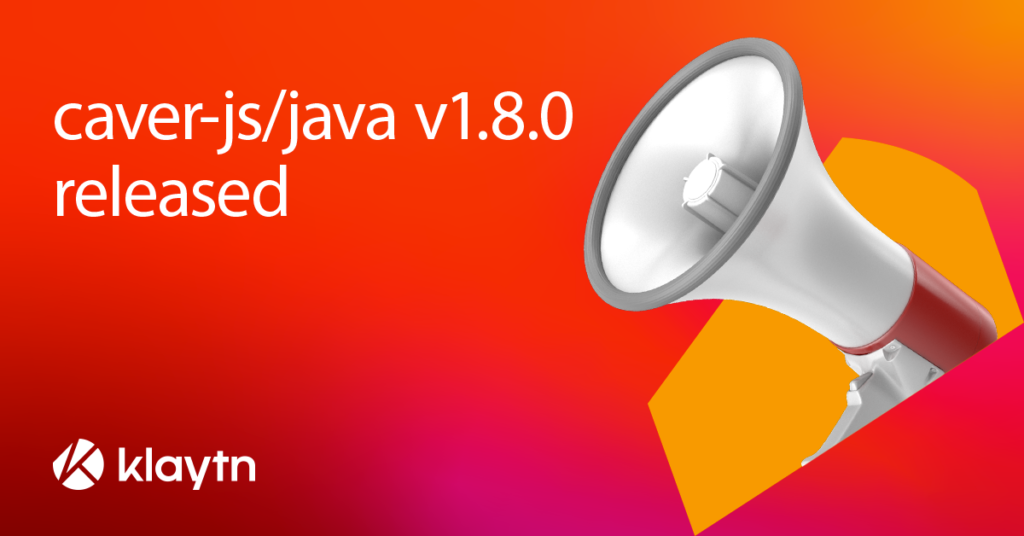
Hi there, friends. Spring is here, and so is caver-js v1.8.0. It will make you laugh, rejoice and appreciate life. (NOT) But trust me, it does have a couple of new features that will make your developer life a bit easier.
If you didn’t know already, now you do: Klaytn supports Ethereum equivalence! And with caver-js v.1.8.0, you can start using Ethereum transaction types and the signatures that go with them. We also fortified our JSON-RPC arsenal for the klay namespace APIs.
## A Breakdown of What’s New in 1.8.0
In line with Klaytn’s pursuit of Ethereum equivalence, Klaytn now supports Ethereum transaction types. You can start using them with caver, via caver.transaction.
- Access lists are now available with
TxTypeEthereumAccessListwhich was introduced with EIP-2930. TheEthereumAccessListclass is available incaver.transaction.ethereumAccessListasTxTypeEthereumAccessList. - The transaction type
TxTypeEthereumDynamicFeepresented in the proposal EIP-1559 is also available. TheEthereumDynamicFeeclass is available incaver.transaction.ethereumDynamicFeeasTxTypeEthereumDynamicFee.
The newly added klay namespace API functions are now available with caver via caver.rpc.klay!
- caver.rpc.klay.getHeader
- caver.rpc.klay.getFeeHistory
- caver.rpc.klay.getMaxPriorityFeePerGas
- caver.rpc.klay.createAccessList
And you can use the ecsign function for the new Ethereum transaction types.
- Just know that you have to sign the transaction types
EthereumAccessListandEthereumDynamicFeeviaecsignto generate the ECDSA signatures. - For the inquisitive: the
vin the signature values {v, r, s} for the new Ethreuem transaction types is a parity (0 for even, 1 for odd) of the y-value of the Secp256k1 curve, whereas thevin Klaytn containschainId, making them incompatible. - Find it here: keyring.ecsign
Klaytn SDK caver-java v1.8.0 Released
Hi there, lovely Java programmers. You are awesome, don’t let nobody tell you otherwise. We have some new features for caver-java v1.8.0, which are going to make your developer life a bit easier.
If you didn’t know already, now you do: Klaytn supports Ethereum equivalence! And with caver-java v.1.8.0, you can start using Ethereum transaction types and the signatures that go with them. We also fortified our JSON-RPC arsenal for the klay namespace APIs.
## A Breakdown of What’s New in 1.8.0
In line with Klaytn’s pursuit of Ethereum equivalence, Klaytn now supports Ethereum transaction types. You can start using them with caver, via caver.transaction.
- Access lists are now available with
TxTypeEthereumAccessListwhich was introduced with EIP-2930. TheEthereumAccessListclass is available incaver.transaction.ethereumAccessListasTxTypeEthereumAccessList. - The transaction type
TxTypeEthereumDynamicFeepresented in the proposal EIP-1559 is also available. TheEthereumDynamicFeeclass is available incaver.transaction.ethereumDynamicFeeasTxTypeEthereumDynamicFee.
The newly added klay namespace API functions are now available with caver via caver.rpc.klay!
- caver.rpc.klay.getHeader
- caver.rpc.klay.getFeeHistory
- caver.rpc.klay.getMaxPriorityFeePerGas
- caver.rpc.klay.createAccessList
And you can use the ecsign function for the new Ethereum transaction types.
- Just know that you have to sign the transaction types
EthereumAccessListandEthereumDynamicFeeviaecsignto generate the ECDSA signatures. - For the inquisitive: the
vin the signature values {v, r, s} for the new Ethreuem transaction types is a parity (0 for even, 1 for odd) of the y-value of the Secp256k1 curve, whereas thevin Klaytn containschainId, making them incompatible. - Find it here:
- AbstractKeyring#ecsign()
- SingleKeyring#ecsign()
- MultipleKeyring#ecsign()
- RolebasedKeyring#ecsign()
